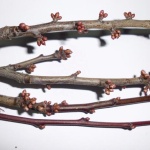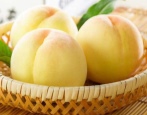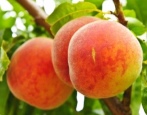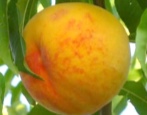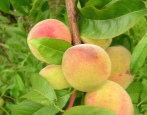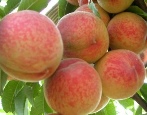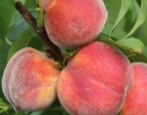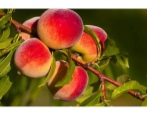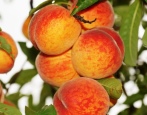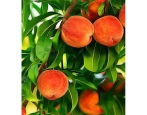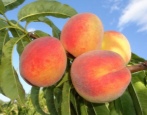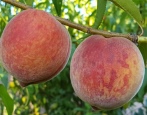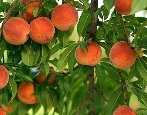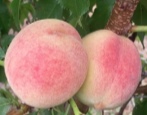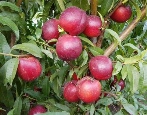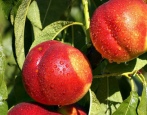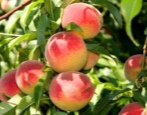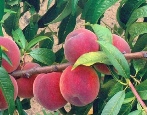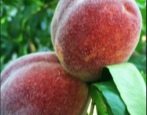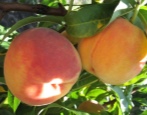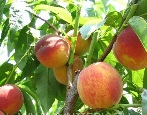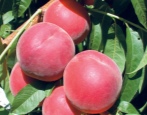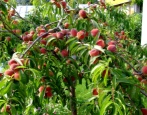
- Authors: Uzbekistan
- Growth type: medium-sized
- Ripening period: early
- Self-fertility: self-fertile
- Appointment: for fresh consumption, for canning
- Marketability: high
- Growing regions: Crimea, Western Ukraine, Moldova, southern Russia
- Bone size: medium
- Separability of the bone from the pulp: bad
- Fruit composition: acids - 0.5-0.6%, sugars - 8.37-11.6%, ascorbic acid - 16.8 mg / 100g fr wt
Growing a nectarine tree in your summer cottage is not at all difficult. To do this, you need to choose a suitable species that will quickly adapt to climatic features, and will also bear fruit well. One of the varieties that deserves attention is the Lola nectarine.
Description of the variety
Lola nectarine is one of the most popular types of Uzbek selection, which is a medium-sized tree with a wide-oval crown shape and a weak spreading of branches. Under favorable conditions, nectarine culture grows up to 5-6 meters in height. The tree is characterized by moderate thickening with dark green leaves, a strong trunk and flexible branches with a brown-brown color.
This type is widely used in the decorative decoration of gardens, since during the flowering period it is densely covered with large pinkish flowers, emitting a delicate aroma of essential oils. The flowers are fixed on the shortened pedicels.
Fruit characteristics
Uzbek nectarine belongs to the category of medium-fruited varieties. On a healthy tree, fruits grow in mass of 80-100 grams. The nectarine has a rounded shape and a classic irregular color - a greenish-cream cover, diluted with a dark red blush that covers most of the fruit. The nectarine peel is smooth, thin, but firm, with a pronounced gloss. A clear abdominal suture is visible on the surface of the fetus.
After harvesting, the fruits tolerate transportation well, and can also be stored for some time without loss of taste and presentation. The variety has a universal purpose - fresh food, use in cooking, conservation, processing into jams, compotes, preserves.
Taste qualities
Lola nectarine has a great taste. The whitish pulp of the fruit is firm, fleshy, tender and slightly fibrous. The peculiarity of the fruits is their juiciness and an incredible dessert-honey aroma. Sweetness is expressed in the taste of nectarine, complemented by a piquant spice. The medium-sized bone inside the fruit is difficult to separate from the pulp. The pulp contains up to 11% sugars and less than 1% acids.
Ripening and fruiting
Lola is a tasty representative of early maturing varieties. Trees bear fruit 3-4 years after planting. Fruiting is regular and stable. You can taste the first fruits in the middle of summer. The peak of fruiting occurs in late July - early August.
Yield
High and stable yield is one of the advantages of this variety. Providing intensive agricultural technology to the culture, you can count on a bountiful harvest. On average, from 1 tree per season, you can harvest from 18 to 35 kg of juicy fruits.
Growing regions
This nectarine variety is quite popular among summer residents and farmers who grow fruit on an industrial scale. The Lola fruit crop is massively grown in the Crimea, in the western part of Ukraine, in Moldova, in the southern part of Russia. In recent years, the tree began to be planted in the central part of the Russian Federation.
Self-fertility and the need for pollinators
The culture is self-fertile, so there is no need for the obligatory planting of donor trees with similar flowering times. In addition, the tree is very attractive to bees and other insects.
Growing and care
Planting of nectarine seedlings is carried out in early spring or in the middle of autumn - a month before stable frosts. The seedling should be with a developed branched root system and a height of up to 150 cm. Be sure to keep a distance of 2-4 meters between the plantings, which will prevent shading. It is not recommended to plant nectarine next to a peach tree.
Crop care includes regular watering, fertilizing three times per season, loosening and mulching the soil, shaping the crown, sanitary removal of dry branches, disease prevention, and protection from rodents.
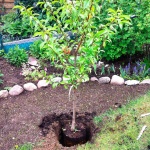
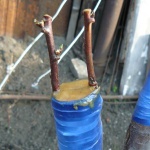
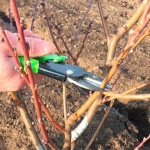
Frost resistance and the need for shelter
The tree's frost resistance is good, so the culture easily tolerates temperature drops to -20-25 degrees. Nectarine does not need shelter.
Disease and pest resistance
The cultivar has a weak immune system, so it is susceptible to diseases such as powdery mildew, curly leaves and fruit rot. In addition, the fruit crop needs protection from insect infestations, as well as from seasonal viruses.
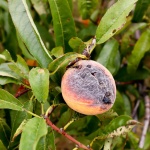
Requirements for soil and climatic conditions
It is recommended to plant a nectarine tree in the southern side of the site, which is well protected from drafts and gusty winds. The soil should be fertile, loose, breathable and moist. It is important that the acidity index is neutral or low. The fruit crop loves a lot of light, air and heat. The passage of groundwater must be deep, since the tree reacts negatively to excessive accumulation of moisture in the soil.
